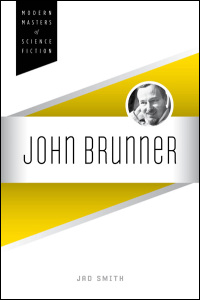 Under his own name and numerous pseudonyms, John Brunner (1934–1995) was one of the most prolific and influential science fiction authors of the late twentieth century. Jad Smith, an associate professor of English at Eastern Illinois University, has written a book on Brunner for the University of Illinois Press’ Modern Masters of Science Fiction series. Smith took time to answer our questions about the book, John Brunner.
Under his own name and numerous pseudonyms, John Brunner (1934–1995) was one of the most prolific and influential science fiction authors of the late twentieth century. Jad Smith, an associate professor of English at Eastern Illinois University, has written a book on Brunner for the University of Illinois Press’ Modern Masters of Science Fiction series. Smith took time to answer our questions about the book, John Brunner.
Q: What is John Brunner known for?
Smith: Brunner is best known for three near-future novels, all of which now seem eerily prescient. His Hugo Award-winning Stand on Zanzibar (1968) is set in 2010 and feels very contemporary in its handling of media saturation, urban overcrowding, terrorism, and genetic modification. The Sheep Look Up (1972) paints a grim picture of unfolding ecological crisis that takes in everything from the emergence of drug-resistant bacteria to the collapse of bee populations and fish stocks. The Shockwave Rider (1975) is a forerunner of cyberpunk. It finds Brunner imagining a “data net” resembling the Internet, coining the term “worm” to describe self-replicating malware, and broadly engaging with the idea of information society.
Q: How did you first become acquainted with Brunner’s writing?
Smith: I first read his Ace books—novels such as The 100th Millennium (1959), The Atlantic Abomination (1960), and Meeting at Infinity (1961)—long after their original publication. I also remember reading two story collections, No Future in It (1962) and Now Then (1965), early on. I mostly worked forward from there. I probably differ from other Brunner fans of my generation, who seem more likely to have read Stand on Zanzibar or The Shockwave Rider first, or to have worked their way back to the better-known novels from The Crucible of Time (1983) or 1980s reprints of The Traveler in Black.
Q: Do you think this circumstance influenced your understanding of Brunner?
Smith: Definitely. His early fiction is often dismissed as little more than the work of a competent journeyman, while Stand on Zanzibar is praised as a masterstroke of unforeseen brilliance. I don’t think that’s the case at all. Brunner’s early stories and
novels are uncommonly good for their day and strongly anticipate his later work. In fact, Meeting at Infinity, with its use of multiple viewpoints, intersecting plot lines, and a false
protagonist, is arguably a trial run for Stand on Zanzibar.
Q: What else is new or different about your account of Brunner’s career?
Smith: I examine Brunner’s troubled relationship with the British New Wave, a loosely-defined SF vanguard of the late sixties. Stand on Zanzibar was received in some quarters as a quintessentially New Wave novel, but it met with a cold reception from some New Wave writers. To an extent, Brunner’s distinctive approach—which combined the best elements of the American pulp tradition with British scientific romance—got caught up in and obscured by crosstalk about the New Wave. Also, Brunner’s best-known novels from the late sixties and early seventies cast a long shadow on his later career. My account gives due attention to Brunner’s significant but neglected later works, The Crucible of Time, “The First since Ancient Persia” (1990), and A Maze of Stars (1991), among others.
 Q: What is an unusual or interesting fact that you learned about Brunner while researching the book?
Q: What is an unusual or interesting fact that you learned about Brunner while researching the book?
Smith: In late 1955, Brunner submitted his proto-cyberpunk story “Fair” to legendary British editor Ted Carnell. Carnell didn’t like it, accepted it only to fill out an issue of New
Worlds, and forced Brunner to publish it under a pseudonym reportedly plucked from the phonebook–Keith Woodcott, specifically. After “Fair” appeared, Carnell received a deluge of positive letters about it and accidently listed Brunner’s real name next to the story in the magazine’s next reader poll, unmasking Woodcott in the process. Brunner found the situation highly amusing and savored the recognition that followed. Later in his career, when he needed to publish some of his Ace books under a pseudonym to avoid overexposure, Brunner revived the Keith Woodcott name, perhaps as something of a private joke.
Q: Has Brunner’s work been influential in the SF field?
Smith: I think so. In Brunner’s day, his body of work was often considered
difficult to categorize. Now, it looks ahead of its time—like a precursor to cyberpunk,
slipstream, and biopunk. I’m not suggesting Brunner invented these subgenres, but his penchant for working across genres and for blurring the boundaries between hard and soft SF certainly helped open up avenues for their emergence.
